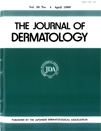Squamous Cell Carcinoma in a Renal Transplant Recipient with Linear Porokeratosis
Abstract
A 40-year-old man developed squamous cell carcinoma on a perianal lesion of linear porokeratosis after renal transplantation. The tumor metastasized to the left inguinal lymph node 25 months after the primary tumor was excised. p53 overexpression was observed in the tumor cells, but not in the porokeratotic lesion. Interestingly, continuous subcutaneous infusion of peplomycin for the lymph node metastasis significantly improved the warty lesions of porokeratosis. In this patient, immunosuppressive agents might have accelerated the development of carcinoma on a skin area with malignant potential.




